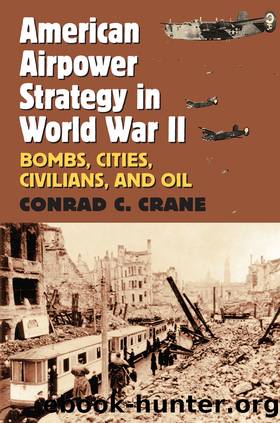American Airpower Strategy in World War II by Conrad C. Crane

Author:Conrad C. Crane [Crane, Conrad C.]
Language: eng
Format: epub
ISBN: 9780700622092
Google: ebbcjgEACAAJ
Publisher: University Press of Kansas
Published: 2016-01-15T03:02:42+00:00
PURSUING A DEATHBLOW AGAINST GERMANY
Meanwhile, other plans to deal an aerial deathblow to the Axis were being pursued against Germany. The Americans had been reluctant participants in such operations in the Balkans, but they could not resist the temptation to try to end the war against the Nazis. Although Omar Bradley and other ground commanders had hoped that air bombardment might defeat the Germans as early as winter 1943, AAF leaders did not really pursue a systematic Todestoss until mid-1944, after the Allies were firmly established on the Continent and the enemy appeared close to collapse.16
In August 1941 President Roosevelt had proposed that the British could demoralize the Germans by bombing small towns across the nation. In December his coordinator of information, William J. Donovan, who worked on special projects against the Nazis with the British, completed a study of German morale predicting that the universal realization âthat ultimate defeat is inevitableâ would bring national collapse, unless the propaganda ministry could instill a sense of âlast-ditch defenseâ in the face of adversity.17 Colonel Edgar Sorenson, Arnoldâs assistant chief of Air Staff for intelligence, concluded in a report two years later that although âpresent evidence indicates that air bombardment alone cannot decisively reduce the morale of the civilian population,â the indirect results of air bombardment or impending military catastrophe might push the German army or the industrialists to ârevolutionary actionâ against the Nazis to preserve the existing social order from irreparable damage.18
A more realistic view of the chances of ending the war through aerial attacks on morale was expressed by Spaatz in his exhaustively documented plan submitted in March 1944 to counter the Transportation Plan in support of OVERLORD. It recognized how completely the Nazis controlled German society and that even refusal to work would just result in resisters being shot. The army was the only group with the potential to challenge the Nazis, and it was more concerned with factories than with workers. The report concluded, âAttacks on industries of direct military importance, therefore, are far more capable of producing significant effects on Army political moves than attacks on non-industrial areas.â19 At the same time, Spaatz directed the Eighth and the Fifteenth Air Forces to prepare operations to attack profitable and relatively undefended industrial targets throughout Germany, an idea he apparently adopted from a rather informal 1942 letter sent to him by a Londoner named E. Frey. Spaatz expected to spread or avoid German ground defenses, extend operational days, and improve accuracy by bombing targets at lower altitudes. He also saw the opportunity to overcome external censorship and impress people and officials throughout Germany with âthe fact of Allied air mastery and its impact.â He cautioned his commanders, however, that official or civilian morale was ânot worthy of being the primary objectiveâ of these operations, which would mainly increase âchances for drawing extra dividends from our regular target systems.â The assignment of USSTAF to SHAEFâs control for the duration of OVERLORD prevented these âbomber sweepsâ from being carried out at that time, but Spaatz continued to refine his concept.
Download
This site does not store any files on its server. We only index and link to content provided by other sites. Please contact the content providers to delete copyright contents if any and email us, we'll remove relevant links or contents immediately.
The Radium Girls by Kate Moore(10910)
The Templars by Dan Jones(4191)
100 Deadly Skills by Clint Emerson(4081)
Rise and Kill First by Ronen Bergman(4014)
The Doomsday Machine by Daniel Ellsberg(3734)
The Rape of Nanking by Iris Chang(3518)
Killing England by Bill O'Reilly(3458)
Hitler in Los Angeles by Steven J. Ross(3441)
Stalin by Stephen Kotkin(3088)
12 Strong by Doug Stanton(3059)
Hitler's Monsters by Eric Kurlander(2734)
Darkest Hour by Anthony McCarten(2649)
Blood and Sand by Alex Von Tunzelmann(2610)
The Art of War Visualized by Jessica Hagy(2413)
Hitler's Flying Saucers: A Guide to German Flying Discs of the Second World War by Stevens Henry(2297)
The Code Book by Simon Singh(2212)
The Second World Wars by Victor Davis Hanson(2136)
Babylon's Ark by Lawrence Anthony(2072)
Tobruk by Peter Fitzsimons(2063)
